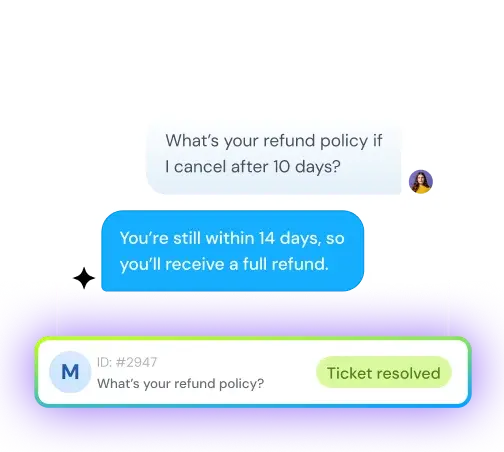What does good customer service actually look like? Let’s break it down
Sneha Arunachalam
Aug 29, 2025
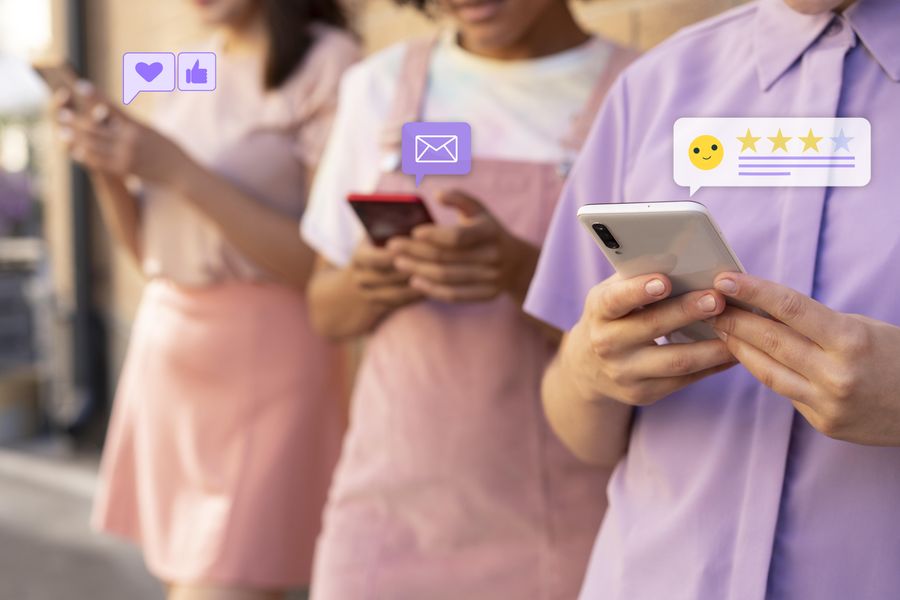
Behind every loyal customer is a moment where they felt seen, heard, and helped.
That moment isn’t random — it’s the result of systems, training, and intent.
In this blog, we’re breaking down what good customer service actually looks like — not just in theory, but in practice. Whether you’re a business owner, support manager, or just curious about what sets the best apart, this blog covers everything you need to know to understand, recognize, and deliver truly standout customer service.
What defines good customer service today?
Customer service used to be that department you called when something broke. Now it's the thing that can make or break your entire business relationship with someone. Knowing what good customer service actually looks like today means understanding that it’s no longer just reactive — it’s strategic, proactive, and deeply personal.
Customer expectations keep rising
Basic problem-solving won't cut it anymore. Today's customers want way more, and the numbers prove it — 95% of decision makers at organizations using AI report significant cost and time savings. Meanwhile, 92% say generative AI helps them deliver better service.
Here's what people actually want now:
- Personal attention - Companies say customers demand services built around their specific needs
- Real human connection - Despite all the tech, consumers still think talking to an actual person matters
The kicker? Even customers paying premium prices now expect live phone support as part of what they're buying.
From waiting for problems to preventing them
Smart companies stopped playing defense. Instead of waiting for things to go wrong, they're getting ahead of issues before customers even notice.
"It's essential to proactively resolve issues before they have any significant business impact," says Jules O'Donnell from Quickbase. This isn't just good customer service — it builds trust.
Think of it like this: 70% of organizations now invest in tech that automatically spots what customers might need next. They're reading the signals and acting on them.
The payoff is huge:
- Fewer angry customers calling in
- Support teams can focus on the complex stuff that really matters
- Customers feel like you actually care about them
Why every touchpoint has to match
Here's where most companies mess up — they nail the experience in one place but drop the ball everywhere else. A McKinsey study found that looking at the whole customer journey predicts satisfaction 30% better than checking individual interactions.
Consistency builds trust in a big way. Customers trusted banks with consistent experiences 30% more than those all over the place. When people know what to expect, they stick around.
Your customers don't care which department they're talking to or what channel they're using. They just want the same quality every single time they interact with your business because that’s what good customer service actually looks like in action.
What does good customer service look like?
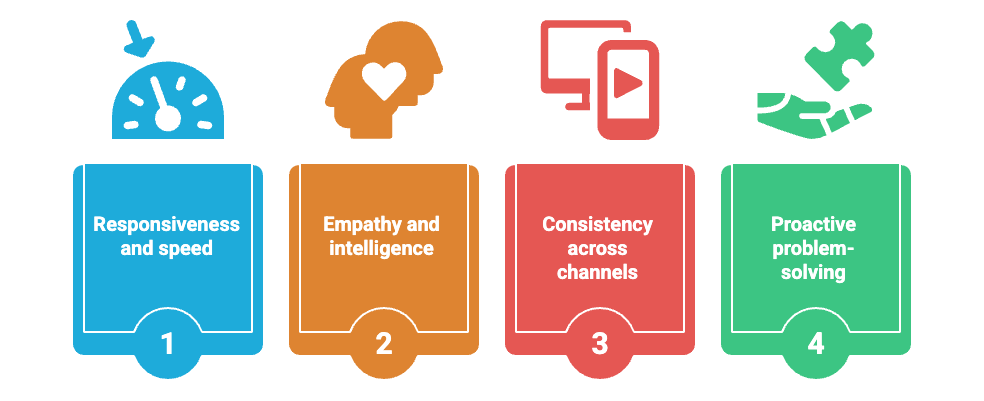
Four things separate companies that people actually want to stick with from those that just... exist. If you're wondering what good customer service actually looks like, it comes down to these pillars — and they're not what most people think.
Responsiveness and speed
Nobody wants to wait around for answers. 77% of customers expect immediate interaction when they reach out, and 83% want their complex problems solved through just one person. The clock is ticking faster than ever.
Think of it like this: if someone's standing at your door with a question, you wouldn't make them wait six hours for an answer. Yet 51% of customers will definitely go elsewhere if that's how long you take to respond. When people were asked what would improve their experience most, "faster response times" topped the list.
Here's what actually works:
- Set clear response time targets internally
- Tell customers upfront how long they'll wait
- Create specific procedures for different types of questions
- Build self-service options for the common stuff
Speed matters, but it shouldn't come at the expense of actually helping people. Sometimes you don't need to respond instantly — just make sure the answer is easy to find when they need it.
Empathy and emotional intelligence
This one's huge. 80% of customers will forgive a mistake if they've had an excellent customer service experience. When someone feels heard and understood, that connection goes way beyond just fixing their immediate problem.
We're talking about actually putting yourself in their shoes. When your customer's frustrated about a delayed order, they don't want a robotic response — they want to feel like you get it. Customers expect companies to adapt to their unique situation, which means one-size-fits-all responses won't cut it.
This kind of emotional intelligence is a huge part of what good customer service actually looks like — it's about more than resolutions; it's about how you make people feel.
What emotional intelligence gets you:
- Stronger trust with customers
- The ability to turn bad situations into good ones
- Better at calming down tense situations
- Deeper relationships that last
How people feel after talking to you becomes how they feel about your brand. One study found that customer feelings were the biggest factor in loyalty — positive experiences made people nearly five times more likely to trust the company and buy more.
Consistency across support channels
Your customers shouldn't have to play roulette with your service quality. Whether they call, email, chat, or find you on social media, the experience should feel like the same company.
People start conversations on one channel and expect to continue them on another without repeating their whole story. That means your phone team needs to know what your email team knows, and your chat support should have the same information as everyone else.
What consistency looks like:
- Same brand message everywhere
- Standardized processes across teams
- One knowledge base everyone uses
- Regular feedback analysis to catch gaps
"Consistency in customer experience refers to delivering a unified and seamless experience regardless of the channel used". When people know what to expect from you, they trust you more.
Proactive problem-solving
The best service happens before customers even know they need help. Instead of waiting for problems to show up, you anticipate them. This completely changes how people think about your company — and it’s a perfect example of what good customer service actually looks like in action.
Here's the disconnect: 61% of service professionals think their companies are proactive, but only one-third of customers agree. That gap shows most businesses have room to improve.
Why proactive service works:
- Uses your resources more efficiently
- Builds stronger relationships
- Creates more loyal customers
- Generates referrals and growth
This could be anything from sending order confirmations to reaching out about potential issues before they become actual problems. The key is identifying and fixing things before they break. When you do this right, you get higher satisfaction, more loyalty, and lower support costs — plus you look like the company that actually pays attention.
4 Building Blocks of Modern Customer Service
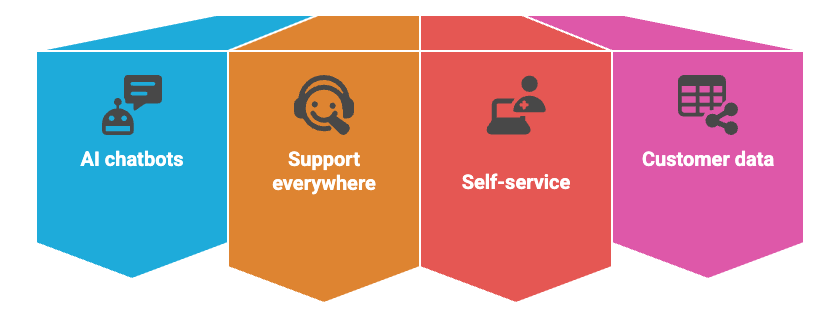
Technology isn't replacing good service — it's making it way easier to deliver. The smartest companies use digital tools to handle the basics so their teams can focus on what really matters: creating connections that keep customers happy.
AI chatbots that actually help
Here's the thing about AI chatbots — when they work well, customers barely notice they're talking to a machine. These virtual assistants now respond in under 5 seconds compared to nearly 3 minutes for human agents. They can understand what you're really asking, ask follow-up questions, and break down complicated stuff into simple answers.
It’s a clear example of what good customer service actually looks like in the modern age: fast, helpful, and frictionless — without sacrificing quality.
Omnichannel support that follows you everywhere
Nobody wants to repeat their story five times across different channels. Omni-channel platforms connect email, phone, chat, social media, and messaging into one smooth experience.
Your customer starts a conversation on Twitter, continues it via email, and finishes with a phone call. The agent sees everything that happened before, so the customer never has to start over.
Self-service that people actually use
Smart customers want to solve simple problems themselves. A good self-service setup includes searchable guides, community forums where customers help each other, AI-powered search, and 24/7 access.
This isn't just convenient for customers — it cuts your costs too. In fact, it’s a major part of what good customer service actually looks like today: giving people the tools to help themselves without frustration or delay. The best-performing companies use these tools to boost revenue while spending less on support, without making the experience worse.
Customer data that tells a story
Think of your helpdesk as a customer's complete story — every interaction, every preference — all in one place. Modern systems use AI to spot patterns and predict what each customer might need next.
When an agent can see someone's entire history before picking up the phone, they can offer personalized help that feels almost psychic. The system might even flag potential problems before customers notice them, turning support into a proactive relationship builder.
Top 4 real-world examples of good customer service
Want to see what good customer service actually looks like? These four companies have cracked the code on turning customer support into a real competitive edge.
1. Chewy: Empathy in action
Chewy gets something most companies miss — pets aren't just products to their owners. They answer 96% of customer calls within four seconds without any of those annoying phone trees. But what really sets them apart is how they handle the emotional stuff.
When one of Chewy’s customers called after their dog passed away, the company didn’t just process the return. They sent flowers and a handwritten sympathy note. When pets die, they often offer refunds and suggest donating unopened food to local shelters. That’s not policy — that’s heart.
Their reps don't get rushed off calls either. While other companies obsess over call times, Chewy encourages spending whatever time customers need. Their vets have stayed on calls for over two hours, just talking pet parents through tough situations. And guess what? Those customers who get that kind of attention stick around longer and spend more.
2. Zappos: Going above and beyond
Zappos built their whole business around one simple idea: "to live and deliver WOW". Free next-day shipping, free returns, and a full year to change your mind about purchases. Most companies hide their phone number — Zappos puts theirs front and center, practically begging you to call.
Their reps can spend unlimited time with customers. Some calls run over an hour, but that's fine by them. When you give people that kind of freedom, magic happens. Word spreads.
3. Ritz-Carlton: Empowered employees
Here's something wild — every Ritz-Carlton employee can spend up to $2,000 per guest, per incident without asking anyone's permission. Housekeepers, bellhops, everyone. They rarely use the full amount, but knowing they can makes all the difference.
As one manager put it: "The amount matters less than showing you trust your employees". This trust has led to legendary stories, like flying special food across the country for a kid with allergies. When your people feel empowered, they do incredible things.
4. Wistia: Personalized video support
Wistia figured out something brilliant — sometimes you need to show, not tell. Their support team creates custom videos to answer customer questions. Instead of writing out complex instructions, they record their screen and walk people through it.
One team member explained it perfectly: "Videos are best for communicating technical concepts or processes. Even if I can explain something clearly with words, it's totally different to be able to show someone how few steps it takes". These personal videos cut resolution times way down while making customers feel like they're getting VIP treatment.
Training and empowering support teams
So by now, one thing’s clear: great service doesn't happen by accident. Behind every smooth customer interaction sits someone who actually knows what they're doing and that only comes from training your support team. That’s a huge part of what good customer service looks like behind the scenes.
Why training matters more than ever
Think of it like this: if you wouldn't send someone into a kitchen without teaching them to cook, why put them on customer calls without proper training? When your team knows their stuff, they handle problems with confidence — and that confidence shows. Customers can feel it, which bumps up purchase likelihood by 81%.
Good training creates a cycle that keeps spinning. Better skills lead to happier employees, which leads to better customer experiences.
Your training should cover the basics:
- Product knowledge and technical skills
- Communication and problem-solving techniques
- Emotional intelligence and empathy development
- Systems and tools proficiency
Creating a feedback loop between customers and staff
Here's what successful companies do — they build a system that turns customer complaints into actual improvements. It's a four-step dance: collect feedback, analyze what you're hearing, make changes, then follow up with customers. That continuous loop is a key part of what good customer service actually looks like in a customer-first company.
Skip this step and you're flying blind. More than half of unhappy customers won't even tell you they're unhappy — they just leave. Your frontline team needs to close these loops fast, usually within hours or days. The bigger patterns? Those inform the systemic fixes.
When you centralize all that feedback, patterns start jumping out at you. No more important stuff getting lost between departments, and you can actually track down what's causing the real problems.
Encouraging autonomy and creativity
Empowerment isn't just a buzzword — it needs three things to work: real authority, clear processes, and the right resources. Get all three lined up and your team can actually solve problems instead of just passing them around.
Want creativity? Make it safe for people to suggest ideas without getting shot down. Celebrate the attempts, not just the wins — that's how you get people thinking outside the box.
Brighthouse figured this out. They let agents issue credits without asking permission first. Six months later? Not a single inappropriate credit issued, plus they saved tons of time and kept customers happier.
When you trust your team to think creatively, everyone wins — higher engagement, better problem-solving, and customers who actually want to stick around.
How to actually know if your service is working
Measuring service quality isn't just about collecting numbers — it's about understanding what your customers really think. These metrics tell you where you're winning and where you're missing the mark.
Customer satisfaction (CSAT)
CSAT is pretty straightforward: it measures how happy customers are with specific interactions. Most companies use a 1-5 scale where customers rate their experience from "very dissatisfied" to "very satisfied". To calculate CSAT, divide the number of satisfied customers (those who responded with 4s and 5s) by the total number of responses, then multiply by 100.
You'll typically send these surveys right after support calls or when someone uses your knowledge base. CSAT gives you immediate insight into service quality, but here's the thing — it only captures how someone felt in that moment. It works best when you pair it with other metrics.
Net promoter score (NPS)
NPS gets at something deeper: customer loyalty. It asks one simple question: "How likely are you to recommend our company to others?" Based on responses, customers fall into three groups:
- Promoters (9-10): Your biggest fans
- Passives (7-8): Satisfied but not excited
- Detractors (0-6): The unhappy ones
Your NPS equals the percentage of promoters minus the percentage of detractors. Scores above 0 are decent, above 50 are excellent, and above 80 are world-class. Unlike CSAT, NPS measures overall loyalty rather than satisfaction with one interaction.
First contact resolution (FCR)
FCR tracks how often you solve customer issues on the first try. Here's why it matters: SQM Group found that improving FCR by just 1% reduces operating costs by 1% while boosting customer satisfaction by 1%. Most companies aim for 70-79%, with 80% considered top-tier.
Customer effort score (CES)
CES asks customers how easy it was to get their problem solved, usually on a 1-7 scale from "very difficult" to "very easy". This metric is a loyalty goldmine — 94% of customers with low-effort experiences plan to buy again, compared to just 4% of those who struggled.
Turning feedback into action
The real magic happens when you close the feedback loop. Companies like Charles Schwab check customer responses every morning. They sort the feedback, decide what to fix first, and actually tell customers about the changes they made.
This approach turns even bad feedback into relationship builders — customers see you're listening and making things better.
The long-term impact of great customer service
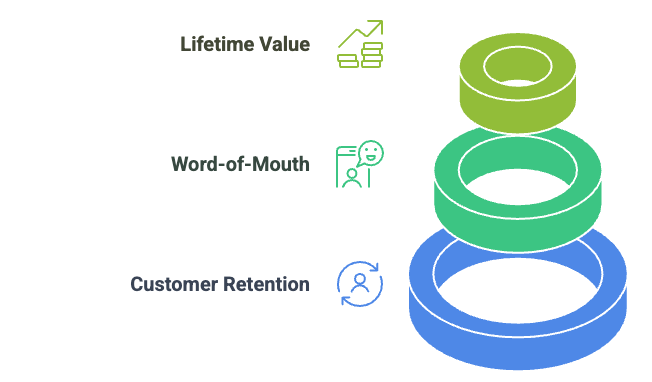
Think of it like this: every great service interaction is an investment that keeps paying dividends. The companies that get this are the ones still standing when their competitors fold, because they understand what good customer service actually looks like in the long run.
Customer retention and loyalty
Keeping the customers you already have beats chasing new ones every single time. A 5% increase in customer retention can boost profits by 25% to 95%. Those aren't small numbers — they're business-changing numbers.
What does loyalty actually look like when you're building it through service? It's making people feel like you actually get them. About 74% of customers develop stronger loyalty to brands that make them feel appreciated.
Here's what's interesting: when things go wrong and you fix them right, customers often end up more loyal than if nothing had gone wrong at all. That closed-loop feedback — where you actually listen and make changes — can turn a frustrated customer into your biggest advocate.
Positive word-of-mouth and referrals
Great service turns your customers into your sales team. And here's the kicker: 92% of people trust recommendations from friends and family above all other forms of advertising.
The math works in your favor:
- Referred customers have a 37% higher retention rate
- 59% of customers would recommend a brand based on service quality alone
- Word-of-mouth gives you free marketing that actually works
When someone has a genuinely good experience with your company, they can't help but tell people about it. That authentic enthusiasm — whether it's shared over coffee or posted on social media — carries weight that no ad campaign can match.
Higher customer lifetime value
Customer lifetime value is basically how much a customer is worth to you over the entire relationship. Service quality has everything to do with this number.
The connection is pretty clear: customers who rate an experience 5/5 stars are more than twice as likely to purchase again. Better yet, 80% of satisfied consumers will spend more with companies they trust.
Good service also opens up opportunities for more revenue. 66% of shoppers prefer brands that know them well enough to recommend relevant items. When you understand your customers, they're more likely to say yes to what you're offering.
Instead of just focusing on individual sales, service quality builds something sustainable. Each positive interaction makes future purchases more likely, increases how much people spend, and extends how long they stick around — all of which add up to a more stable, profitable business.
Conclusion
In the end, what good customer service actually looks like isn’t just fast replies or fancy tools — it’s care.
So,good customer service isn't about checking boxes in 2025. We've seen how expectations have shifted — customers want both smart technology and real human understanding. They want companies that actually care.
What does good customer service mean to you? Maybe it's Chewy answering calls in four seconds and sending flowers when someone's pet dies. Maybe it's Ritz-Carlton trusting every employee with $2,000 to fix problems on the spot. These companies get something others miss — service is about people, not processes.
Sure, AI chatbots and predictive analytics matter. They handle the routine stuff so humans can focus on what really counts. But here's what won't change: empathy, genuine care, and treating customers like actual people instead of ticket numbers.
The math works too. Better service means customers stick around longer and spend more. They tell their friends. They become your biggest advocates without you paying for ads.
Think of it like this: if every interaction is a chance to show you care, what kind of company would you become? The businesses winning in 2025 will be the ones that remember there's a real person behind every email, every chat, every call.
Great service pays off way beyond the moment. When you make someone feel heard today, you've got a customer for life.
Quick summary: What does good customer service look like? from theory to practice
What does good customer service look like in today's competitive landscape? It's no longer just about fixing problems—it's about creating moments where customers feel genuinely seen, heard, and valued. Modern service has evolved from reactive problem-solving to strategic, proactive relationship-building that can make or break your entire business.
- Speed & responsiveness: Customers expect immediate interaction and quick resolution of their issues
- Emotional intelligence: Great service means showing empathy and making customers feel genuinely understood
- Consistency across channels: Whether phone, email, or chat, the experience should feel seamless and unified
- Proactive problem-solving: The best companies anticipate and prevent issues before customers even notice them
- Real-world excellence: Companies like Chewy, Zappos, and Ritz-Carlton demonstrate exceptional service through empowerment, unlimited support time, and going above and beyond for customers
Understanding what does good customer service look like ultimately comes down to one word: care. When you combine smart technology with genuine human empathy, you create experiences that turn customers into lifelong advocates. Great service isn't just good business—it's the foundation for sustainable growth and lasting success.
Frequently Asked Questions
In 2025, good customer service means combining fast, AI-powered support with genuine human empathy. Customers expect proactive help, personalized experiences, and consistent service across all channels — whether it’s chat, email, phone, or self-service.
Proactive service is about anticipating needs and solving issues before customers even ask. It could be an early warning, an apology before a complaint, or helpful info sent at just the right time.
Must-haves include a help desk or ticketing system, knowledge base software, live chat, customer feedback tools, CRM integration, and AI/chatbot solutions.
Real-time dashboards help managers track volume spikes, SLA breaches, and agent performance. This enables immediate action — reallocating staff, escalating tickets, or adjusting workflows on the fly.
Customer support is the assistance you give when someone has a question, issue, or need — it's reactive, focused on solving problems.
Customer experience (CX) is the full journey a customer has with your brand — from the first click to post-purchase follow-up.
Support is just one part of the overall experience.
While support is about fixing, CX is about feeling — it includes design, tone, speed, ease, and trust.
Put simply: support is a moment; experience is the whole story.
